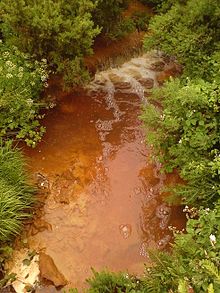Transport and chemical reactions of water pollutants
See also: Marine pollution
Most water pollutants are eventually carried by rivers into the oceans. In some areas of the world the influence can be traced hundred miles from the mouth by studies using hydrology transport models. Advanced computer models such as SWMM or the DSSAM Model have been used in many locations worldwide to examine the fate of pollutants in aquatic systems. Indicator filter feeding species such as copepods have also been used to study pollutant fates in the New York Bight, for example. The highest toxin loads are not directly at the mouth of the Hudson River, but 100 kilometers south, since several days are required for incorporation into planktonic tissue. The Hudson discharge flows south along the coast due to coriolis force. Further south then are areas of oxygen depletion, caused by chemicals using up oxygen and by algae blooms, caused by excess nutrients from algal cell death and decomposition. Fish and shellfish kills have been reported, because toxins climb the food chain after small fish consume copepods, then large fish eat smaller fish, etc. Each successive step up the food chain causes a stepwise concentration of pollutants such as heavy metals (e.g. mercury) and persistent organic pollutants such as DDT. This is known as biomagnification, which is occasionally used interchangeably with bioaccumulation.Large gyres (vortexes) in the oceans trap floating plastic debris. The North Pacific Gyre for example has collected the so-called "Great Pacific Garbage Patch" that is now estimated at 100 times the size of Texas. Many of these long-lasting pieces wind up in the stomachs of marine birds and animals. This results in obstruction of digestive pathways which leads to reduced appetite or even starvation.

No comments:
Post a Comment